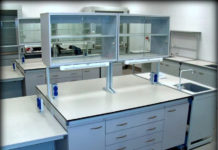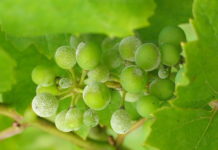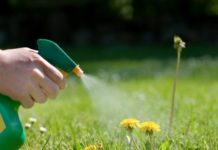My home is my fortress, but is it as safe and secure as it seems? Trying to make our home cozy and comfortable, we often forget about safety rules. As a result, the air is filled with toxic fumes, which are emitted by fashionable upholstery or laminate. Of course, the amount of released substances is insignificant and will never cause acute poisoning.
But if there are many things in the house containing hazardous compounds, the ventilation regime is not observed, or it is ineffective due to the poor ecology of the metropolis, over time, the accumulation of toxins will lead to serious health problems. To avoid negative consequences, you need to very carefully select interior items, regularly ventilate the home and use indoor plants that purify the air.
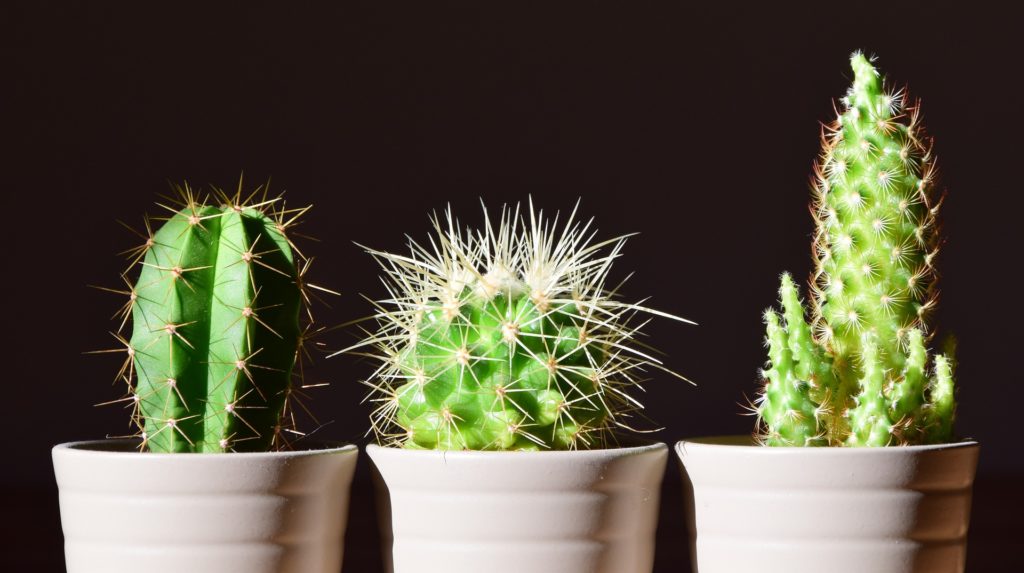
Content
What the air of an ordinary apartment can contain
On average, a metropolitan resident spends about 60% of his time in an apartment. Agree, hardly any of us, coming home from work, thinks about the composition of the air in his home. Although everyone knows from the school course that a lot of gaseous compounds accumulate in an enclosed space. According to their effect on the human body, they can be divided into useful, inert and toxic. Let's take a closer look at the last group. What can hide the air of an ordinary city apartment:
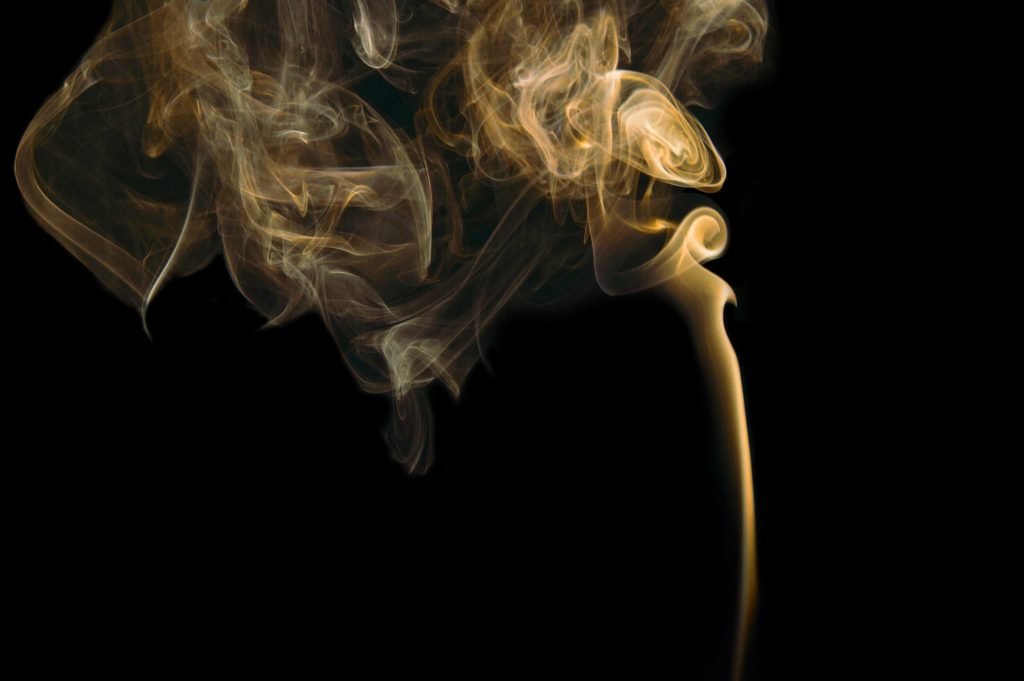
- Formaldehyde is a colorless gas that has an irritating and carcinogenic effect, causes allergic reactions, and can cause the development of bronchial asthma. Sources of fumes can be: furniture, carpet, upholstery, plastic items, tobacco smoke.
- Benzene is one of the most powerful carcinogens, especially dangerous due to its ability to accumulate in the body. In children, it can provoke the development of leukemia, in adults it causes a feeling of shortness of breath, convulsions. It gets into the air of an apartment with tobacco smoke, cleaning agents, it is found in many paintwork, rubber products.
- Trichlorethylene is a colorless, transparent, volatile liquid that causes lacrimation, redness of the mucous membranes of the eyes, pruritus, psychomotor agitation, especially in young children, can cause the development of cancer and renal failure. Vapors are emitted from freshly painted walls, lacquered furniture, ink for cartridges, and carpet cleaners.
- Ammonia in small concentrations causes discomfort, constant headaches, dry mucous membranes, cough, pressing chest pains. Contained in various household appliances, computers, tobacco smoke, detergents.
- Phenol - the constant effect of this substance causes a malfunction in the liver, cardiovascular, excretory and nervous systems. Linoleum, cabinet furniture, wallpaper, stretch ceilings and even children's toys can be sources of fumes.
The air in rooms can also be contaminated with pollen, combustion products, exhaust gases, bacteria, fungal spores.
How indoor plants purify the air
Houseplants are able to neutralize up to 84% of hazardous compounds contained in the atmosphere of living rooms. But how do they purify the air? By absorbing hazardous substances together with carbon dioxide, some of them turn into non-toxic compounds, others are converted into non-volatile forms that are safe for humans. Further, soil microorganisms are connected to the work, completing the processing process.
Plants of some species are able not only to purify the air of living quarters from harmful substances, but also help to reduce the content of viruses, bacteria, molds in it by releasing phytoncides. The greatest amount of active substances is released during the flowering period. For many tropical flowers, this period lasts from November to March, which just coincides with the time of rampant colds.

It is important to remember that only healthy plants, when properly cared for, release enough phytoncides.
The results of numerous studies have shown that for the best results, you need 1-2 medium-sized plants for every 5-10 square meters of room.
Correctly selected green compositions can become not only an interior decoration, but also an effective natural filter for air purification.
Advantages
- neutralize up to 84% of harmful substances, including benzene, phenol;
- during the day, the room air is additionally saturated with oxygen;
emit phytoncides; - produce essential oils that help relieve nervous tension, headaches, improve the quality of sleep and the work of the cardiovascular system;
- have a calming effect, improve mood, allow you to quickly switch attention;
- increase the level of humidity;
- trap dust particles.
disadvantages
- can cause allergic reactions;
- the presence of flowers with a strong spicy aroma in the room can cause a deterioration in well-being;
- some plants can be toxic to pets;
- thorny plants, sharp leaves can cause injury.
| Plants | Where to put | Cleans the air from |
|---|---|---|
| Asparagus | kitchen | phenols, carbon monoxide, heavy metal vapors |
| Aloe (Centenary) | bedroom, living room | formaldehyde |
| Begonia | bedroom | almost all volatile compounds |
| Geranium (Pelargonium) | bedroom | carbon monoxide, phenols |
| Dracaena | living room, kitchen | formaldehyde, phenols, benzene, trichlorethylene |
| Kalanchoe | bedroom | formaldehyde |
| Cypress | children | 5 main pollutants |
| Lavender | bedroom | phenols and formaldehyde |
| Lemon Tree | children bedroom | 5 major pollutants, dust |
| Indoor ivy (Hedera) | living room, kitchen | formaldehyde, trichlorethylene, benzene, ammonia |
| Sansevieria (Pike tail, Mother-in-law's tongue) | children | formaldehyde, dust |
| Spathiphyllum Chlorophytum | children | most dangerous vapors |
| Ficus Benjamin | living room, kitchen | formaldehyde, phenols, trichlorethylene, benzene |
| Scheffler | living room, kitchen, office, where people smoke | formaldehyde, benzene, tobacco smoke, toluene |
A selection of indoor plants for the nursery
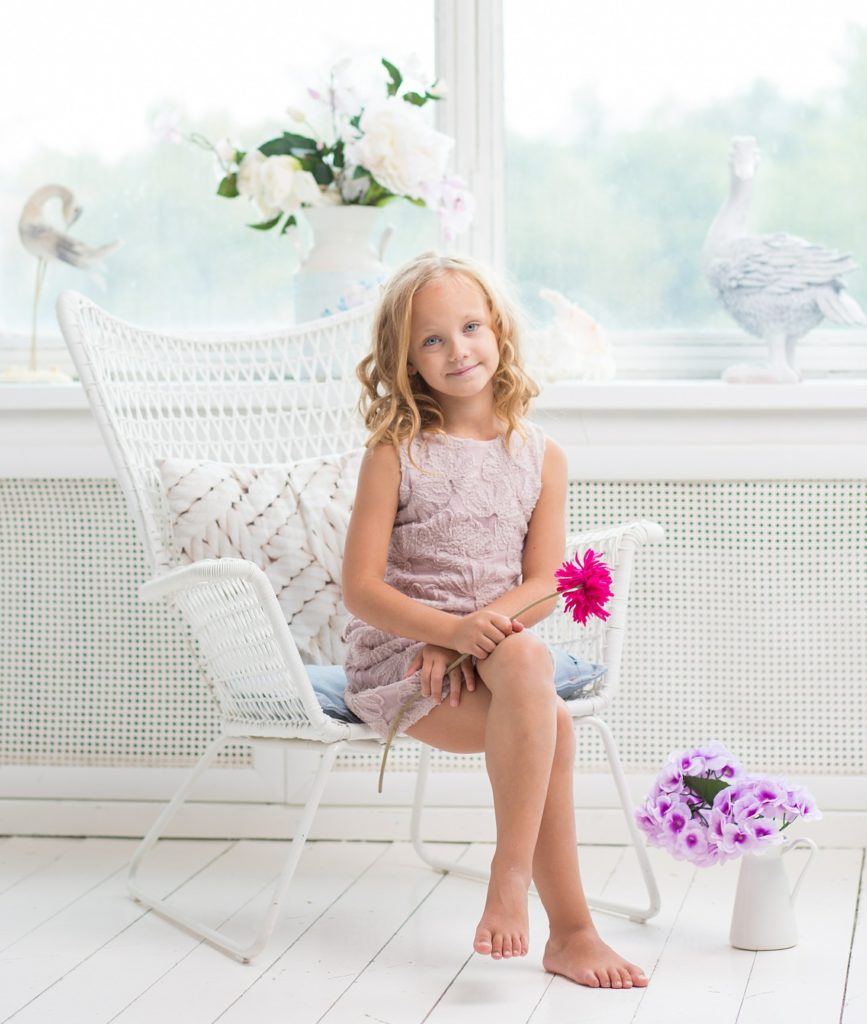
The selection of indoor plants for cleaning the air of a nursery requires a special approach. Plants should not only absorb harmful fumes well, give maximum oxygen, but also themselves be absolutely safe for the baby, even if he accidentally eats a couple of leaves. Correctly selected green compositions will add coziness, help create a favorable microclimate, and improve the emotional state of the child. When choosing a natural filter for a nursery, keep in mind that:
- leaves, flowers, seeds should not contain toxic substances;
- avoid species with thorns, sharp leaves or shoots;
- give preference to hypoallergenic species;
- flowers should not have a strong or pungent odor;
- the child should like the composition, evoking only positive emotions.
Introducing a selection of indoor plants that are ideal natural filters for your nursery.
Sansevieria (Pike tail, Mother-in-law's tongue)
A plant with beautiful fleshy, long, dark green leaves with horizontal, lighter stripes and white small flowers. One of the most common types is three-lane sansevieria. He has many varieties with different patterns on the leaves. The average price is 1200 rubles.

Advantages
- grows rapidly;
- durable and unpretentious;
- cleans the air well, is able to capture and completely neutralize formaldehyde;
- moderate watering is required, limited in winter;
- feed with universal liquid fertilizer.
disadvantages
- you need to often wipe the leaves: dust particles clog the pores and prevent the plant from purifying the air from harmful impurities;
- drainage is required, at least ⅓ of the pot;
- does not tolerate high humidity;
- prefers bright, but diffused light.
Spathiphyllum Chlorophytum
Perhaps this is the most active and budgetary natural filter. Chlorophytum, like a sponge, absorbs impurities of harmful substances, giving in return pure oxygen. The leaves can be green, white-green, or creamy green. Absolutely harmless, even if a curious kid decides to taste it. The average price of an adult plant is 800 rubles, but you can just ask your friends for a sprout, chlorophytum takes root well and grows quickly.
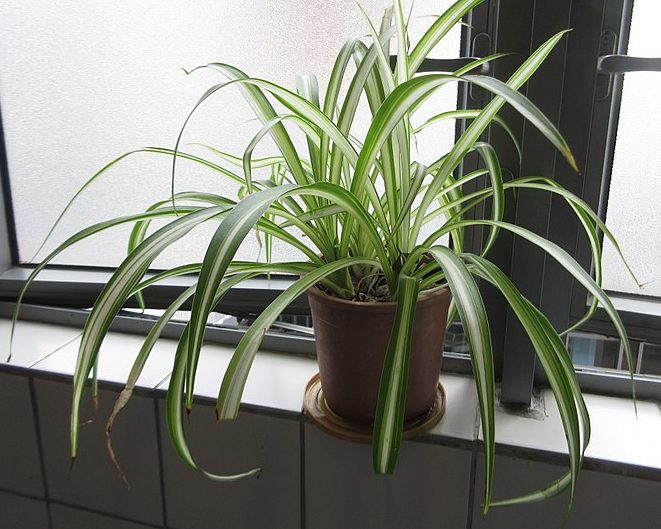
Advantages
- perfectly neutralizes most hazardous fumes;
- if a small amount of coal is added to the soil, the cleansing properties of chlorophytum will increase several times;
- promotes air humidification;
- safe for children, pets;
- unpretentious, grows well in the sun and in the shade, at temperatures from +8;
- ideal for "forgetful" growers, can use the moisture stored in the roots for some time.
disadvantages
- with improper care, it looks sloppy;
- affected by thrips;
- cats love to eat young shoots, play with regrown mustaches.
Cypress
Cypress is a wonderful air purifier for a nursery. Outwardly it resembles a miniature Christmas tree and is very popular with children. The coniferous plant produces phytoncides that destroy the pathogenic microflora of the air. Prefers wide clay pots and well-drained, well-moistened soil. The average price is 700 rubles.

Advantages
- cleans the air from 5 main pollutants;
- attracts dust;
- releases phytoncides;
- looks great in the interior.
disadvantages
- needs regular spraying, at least 1 time per week;
- does not tolerate high temperatures;
- requires good room illumination, but is sensitive to direct sunlight.
Lemon Tree
Thanks to the presence of a lemon tree in the nursery, the air will be cleared of phenols, trichlorethylene, benzene, and will be filled with freshness and essential oils. With good care, edible fruit can be produced. The plant can be grown from seed or purchased as an adult. The average price is from 2300 rubles.
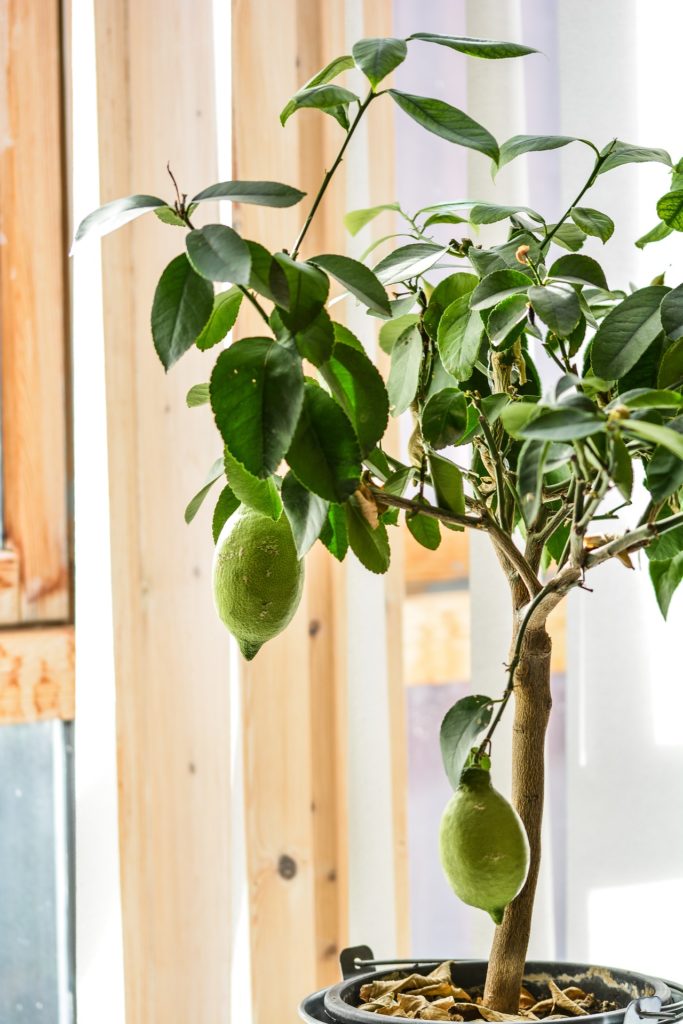
Advantages
- releases essential oils with bactericidal and soothing effects;
- there is no bright, intrusive smell;
- neutralizes hazardous substances well;
- collects dust;
- can bear fruit;
- decorates the interior.
disadvantages
- does not like being moved;
- requires good room illumination, but is sensitive to direct sunlight;
- very capricious, reacts to any temperature changes or violation of the irrigation regime by dropping leaves;
- grows large enough, not suitable for small rooms.
A selection of indoor plants for the bedroom
A person spends about 30% of their time in the bedroom. The quality of sleep directly depends on the microclimate in the room, including the composition and humidity of the air. Correctly selected plants can not only cleanse the air of harmful impurities, but also solve problems with sleep. It is important to remember that there should not be a lot of greenery in the bedroom. At night, when photosynthesis stops, green filters use oxygen in the air.One or two medium-sized plants are considered optimal. For example:
Lavender
The southern visitor will be an excellent air purifier in the bedroom if you provide her with the right conditions. The average price is 800 rubles.
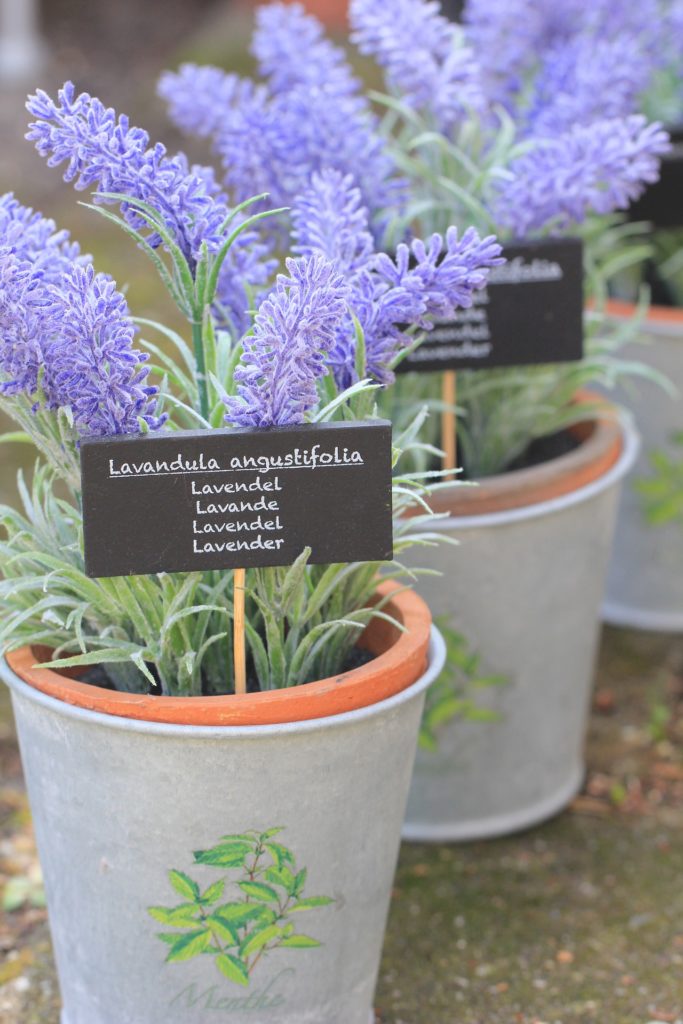
Advantages
- secretes essential oils that repel insects, improve sleep quality, promote relaxation and reduce nervous tension;
- neutralizes phenols and formaldehyde;
- does not require frequent watering, the optimal regimen is 1 time in 7-10 days;
- decorates the interior.
disadvantages
- demanding on lighting conditions, often requires additional artificial lighting;
- may cause allergies;
- hibernates for 3 winter months.
Aloe (Centenary)
An unpretentious succulent is great for the bedroom, as it consumes very little oxygen, and produces it for almost 20 hours a day. In the hot season, aloe needs a fairly abundant watering. In winter, you need to water it once every 10-12 days. The average price is 300 rubles for a young plant.
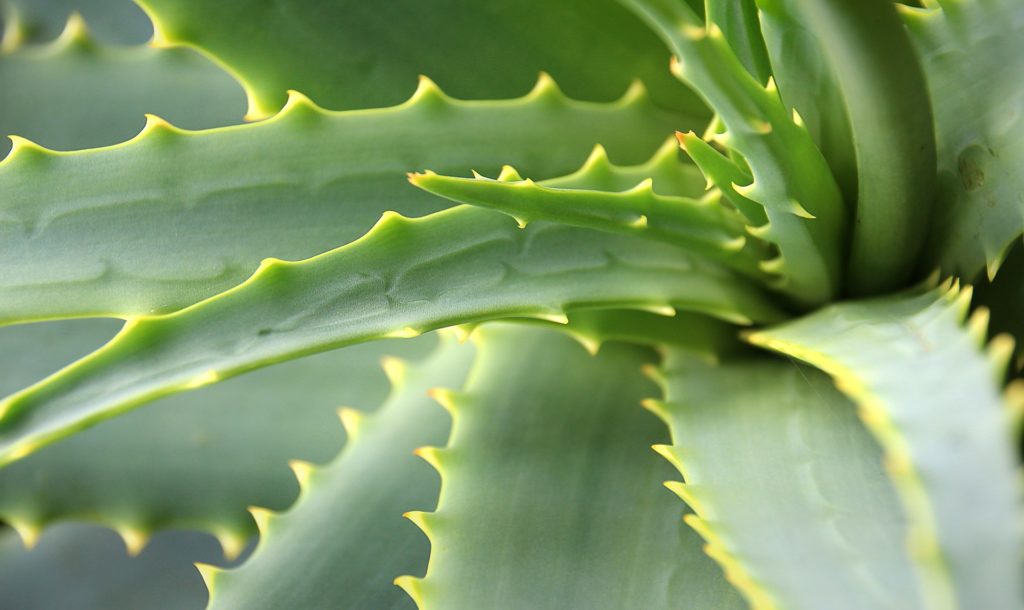
Advantages
- unpretentious to lighting conditions, temperature conditions;
- neutralizes formaldehyde well;
- can be used for medicinal purposes;
- hypoallergenic;
- growing rapidly.
disadvantages
- you need to water only with water at room temperature;
- not very presentable appearance;
- does not bloom at home.
Kalanchoe
Kalanchoe is quite unpretentious, it cleans the air well from volatile compounds. It can act not only as a green filter, but also as an interior decoration. Flowers are collected in neat umbrellas of white, red, yellow or light pink color. The average price is 200 rubles for a seedling, from 600 for a flowering plant.

Advantages
- perfectly removes formaldehyde;
- well tolerates both direct sunlight and shade;
- can be used for home cosmetic procedures and in traditional medicine;
- not toxic;
- can do without watering for a long time.
disadvantages
- feeding is obligatory once a month;
- almost does not affect the content of phenol, benzene, dust.
Begonia
There are many varieties of the plant. One of the most popular species with good cleansing properties is royal begonia. It is a hybrid, with beautiful rounded brownish-pink or brownish-purple leaves with scalloped edges and a white, silver, or green border. The average price for a flowering plant is 950 rubles.
Advantages
- neutralizes well almost all volatile compounds;
- releases phytoncides;
- reduces the content of staphylococcus in the air by 70%;
- blooms actively in winter;
- can be used in traditional medicine.
disadvantages
- leaves, stems and flowers are poisonous, pots should be placed out of the reach of children and pets;
- photophilous, but does not tolerate direct sunlight;
- prefers temperatures between 13 and 21 degrees.
Geranium (Pelargonium)
Geraniums are popular, unpretentious and willingly flowering plants. Flower pots should be placed at some distance from the bed. The scent of flowers and the secreted essential oils improve sleep quality, but too much concentration can cause headaches and insomnia. The average price for a flowering plant is 700 rubles.
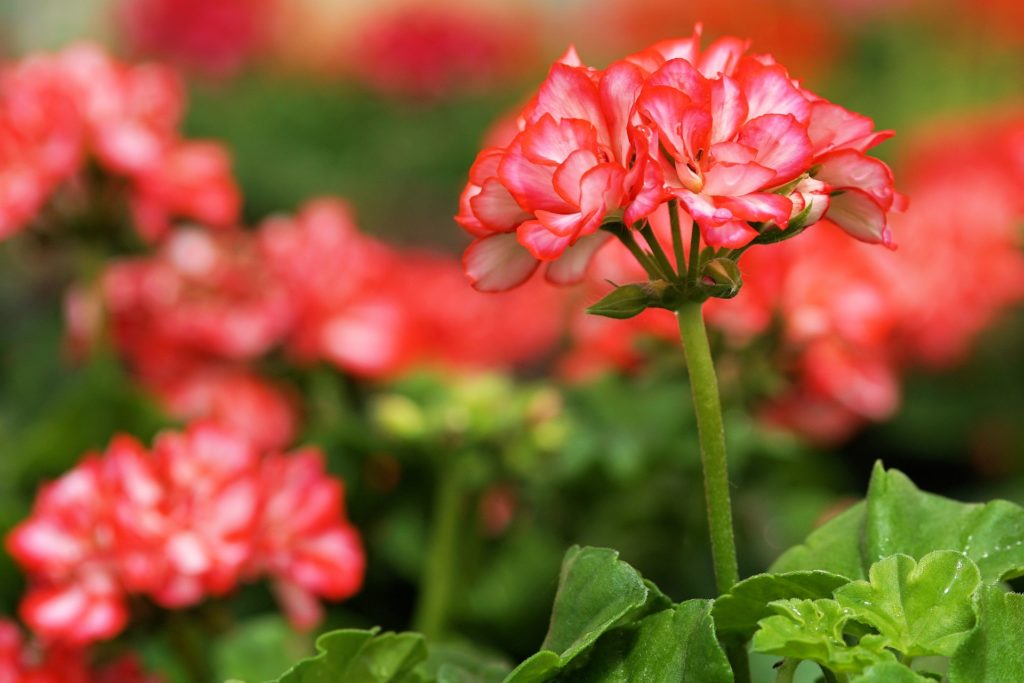
Advantages
- possesses bactericidal properties;
- improves sleep, calms the nervous system;
- the aroma refreshes stale air;
- neutralizes carbon monoxide, phenols;
- the smell scares off flies.
disadvantages
- photophilous, winter requires the use of phytolamps;
- toxic;
- essential oils in high concentration cause headaches and insomnia.
A selection of plants for the living room and kitchen
It is equally important to monitor the air quality in the living room or kitchen, where the whole family gathers in the evenings. Green corners will not only add coziness to the room, but also protect household members from the harmful effects of volatile compounds.
Scheffler
Scheffler is a real find for smokers. The plant is excellent at absorbing nicotine and tar emitted from tobacco smoke. If you place the plant in the kitchen, it will also absorb the combustion products of household gas and other harmful compounds that enter the air.The average price for an adult flower is from 800 rubles.
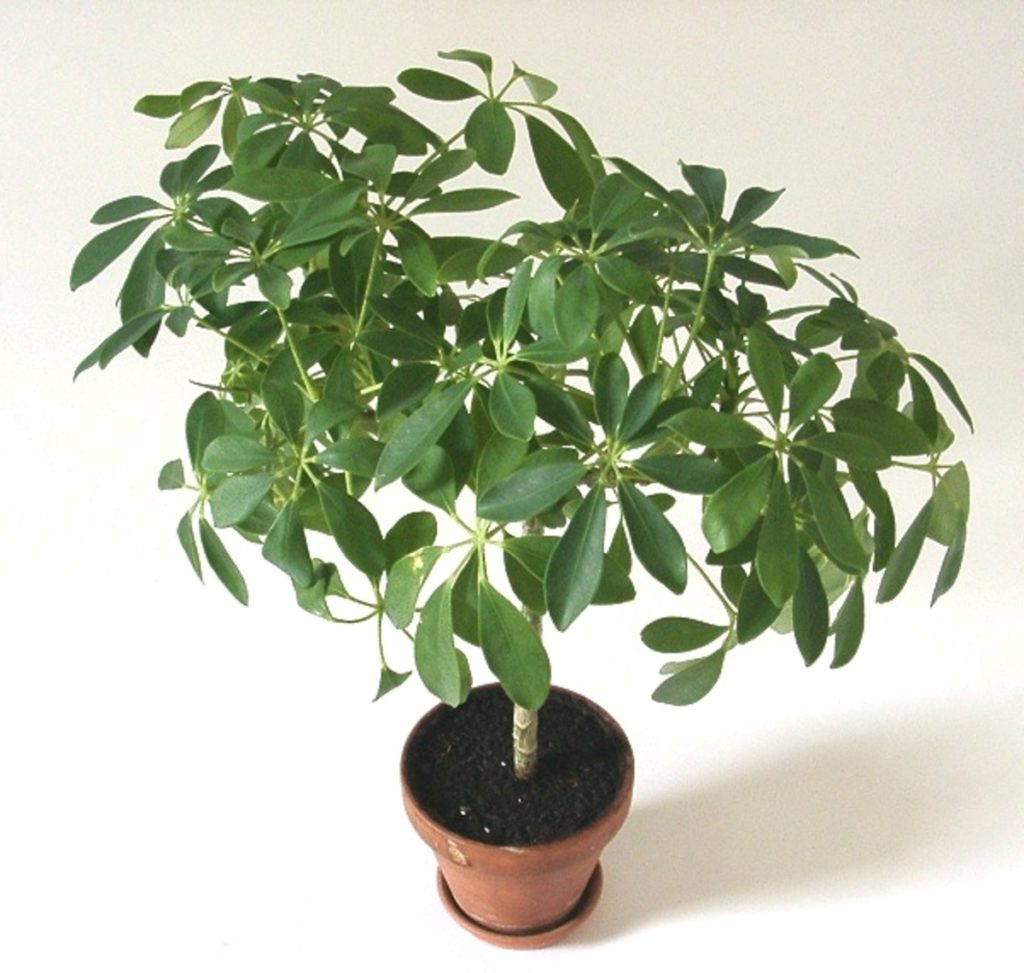
Advantages
- neutralizes formaldehyde, benzene, tobacco smoke, toluene;
- there are many decorative types;
- grows quickly and restores greens after illness;
- with proper care, it can grow up to 2 meters in height.
disadvantages
- photophilous, but does not tolerate direct sunlight;
- prefers high humidity, you need to spray and wipe the leaves with a damp cloth 2-3 times a day;
- poisonous.
Ficus Benjamin
Ficus is well suited for a living room or kitchen, rightfully considered the leader among natural filters that absorb harmful substances emitted by furniture and furnishings. The average price for a very young tree is 800 rubles, for an adult, with a height of 100 cm - from 6,000 rubles.
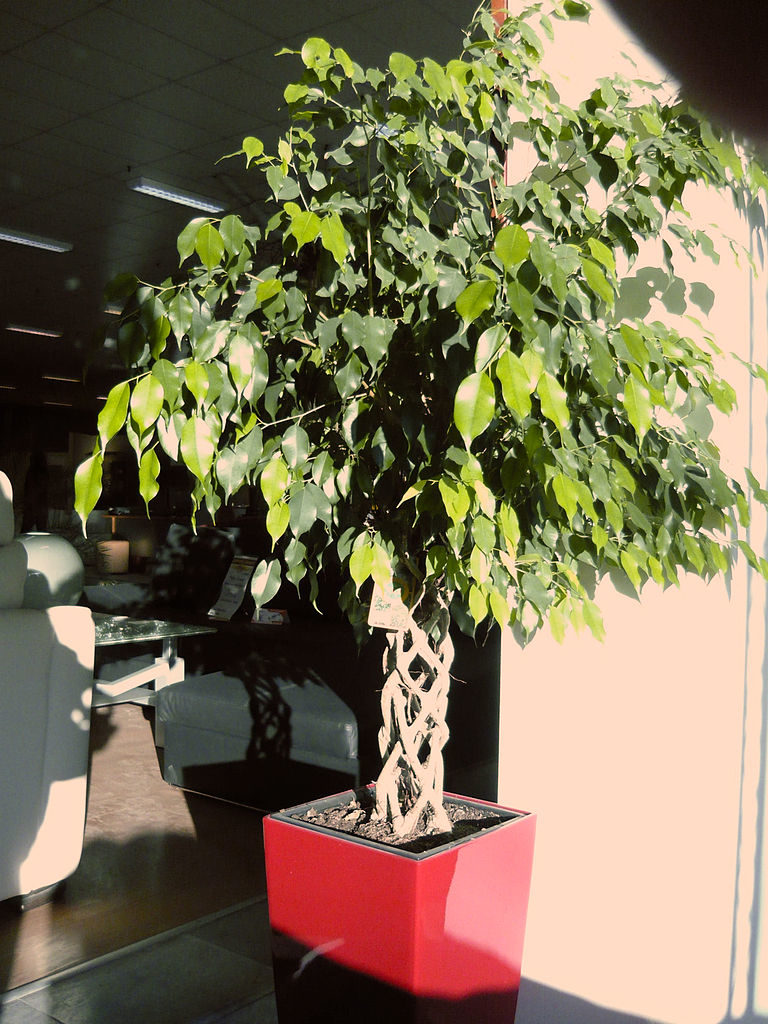
Advantages
- neutralizes formaldehyde, phenols, trichlorethylene, benzene;
- actively produces oxygen;
- promotes air humidification;
- releases phytoncides;
- excellent interior decoration;
- grows up to 1.5 meters in height.
disadvantages
- photophilous, often requires the use of phytolamps;
- for irrigation, filtered, settled or warm boiled water is required;
- may cause allergies;
- the leaves are poisonous, especially to cats.
Indoor ivy (Hedera)
This green filter is presented in more than 30 varieties, but they all share the ability to neutralize most hazardous compounds that enter the air of an apartment. The average price is 1000 rubles.

Advantages
- neutralizes formaldehyde, trichlorethylene, benzene, ammonia;
- looks good in the interior;
- growing rapidly;
- unpretentious in care.
disadvantages
- does not tolerate high temperatures;
- requires support for growth;
- some species are poisonous.
Dracaena
A very interesting option for landscaping a living room or kitchen is dracaena. The plant perfectly cleans the air from hazardous vapors of paint and varnish products, furniture made of chipboard, plastic. The average price is from 4000 rubles.
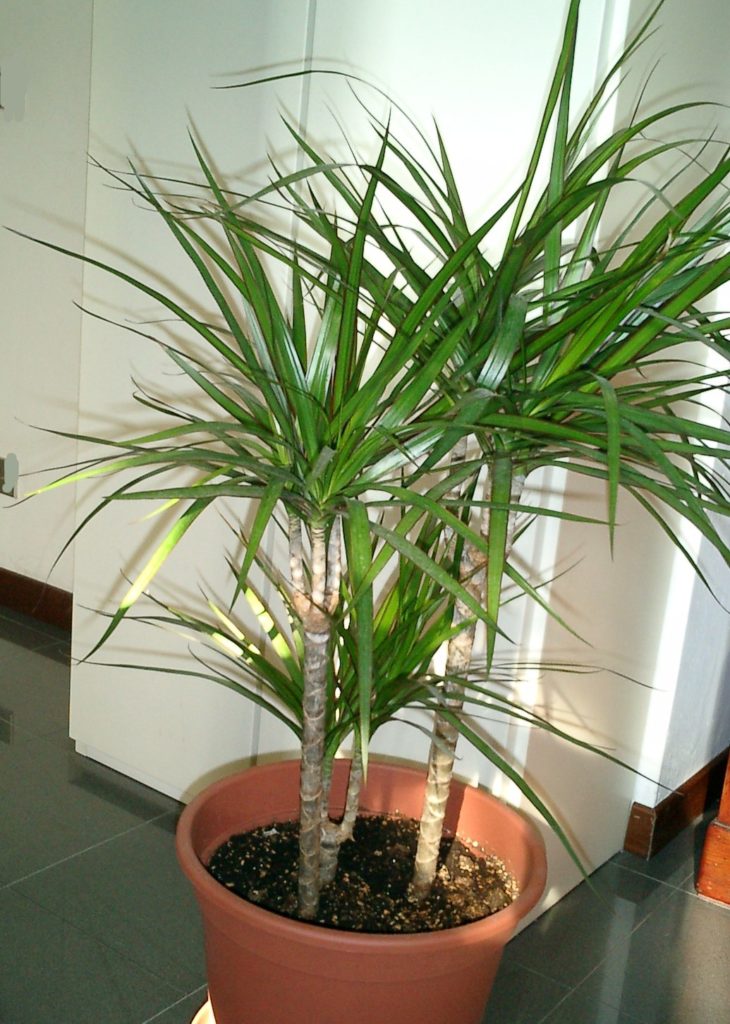
Advantages
- neutralizes formaldehyde, phenols, benzene, trichlorethylene;
- collects excess dust;
- practically does not cause allergic reactions.
disadvantages
- a very capricious plant, requires daily watering and spraying;
- photophilous, but afraid of direct sunlight;
- toxic to animals.
Asparagus
An unpretentious plant with lush, thin stems, ideal for decorating a living room or kitchen. According to Feng Shui, asparagus clears the energy of the apartment from negative emotions, helps to cope with sadness and depression. It perfectly cleans the atmosphere not only from carbon monoxide, but also from vapors of heavy metals. The average price is 600 rubles for an asparagus 20 cm high.

Advantages
- neutralizes phenols, carbon monoxide, heavy metal vapors;
- unpretentious in care;
- promotes air humidification.
disadvantages
- a transplant is required immediately after purchase;
- afraid of drafts;
- the berries of the plant are poisonous.
Before choosing a plant to purify the air in your home, be sure to make sure it is safe for you and your pets. Check if the selected type of allergic reactions, if you can provide proper care. Only healthy plants are fully capable of performing the function of green filters. Properly selected compositions will not only cleanse the air from harmful impurities, but will also help improve the quality of life and health.


